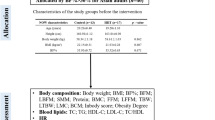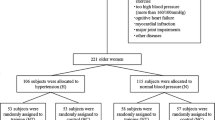Summary
Aim
Increased arterial stiffness is an important risk factor for the development of cardiovascular disease. The aim of the present study was to compare arterial function and other anthropometric parameters in trained vs sedentary, healthy young students. Furthermore, the study explores the relationship between arterial stiffness and eating behavior in these students.
Methods
Two groups of healthy university students were recruited for this study. The first group consisted of 10 men and 8 women (mean age: 23.27 ± 3.2 years) with an athletic predisposition. Furthermore, over the course of 6 months this group participated in 60-min training sessions designed as interval training circuits with a frequency of three to five times a week. For comparison, a group of age-matched sedentary students (5 men and 13 women; 24.27 ± 2.6 years) were recruited from the same institution.
Weight, height, body mass index (BMI), as well as neck and abdominal circumferences (ABs) were recorded. Arterial tension, heart rate, arterial stiffness measurements were simultaneously determined. Lastly, all students completed a 51-item “Eating Behavior Patterns Questionnaire”.
Results
Age, weight, BMI, AB, and blood pressure were not significantly different between the two groups (p > 0.05). The moderately aerobic trained students showed a significantly lower heart rate, neck circumference, and arterial stiffness as compared with their untrained, sedentary counterparts. Additionally, pulse wave velocity (PWV) measurements were correlated to a lower weight, heart rate, blood pressure, AB, and neck circumference (p < 0.05) found in trained subjects at the end of the 6-month training period.
Furthermore, the nutritional habit analysis showed that in the sedentary group, snacking, emotional eating, and cultural/lifestyle behaviors are positively correlated with PWV (p < 0.05).
Conclusion
Healthy subjects with higher PWV may benefit from consistent aerobic exercise training to improve arterial stiffness. Our eating behavior study shows that healthy eating may improve vascular function and therefore can reduce the risk of cardiovascular diseases.



Similar content being viewed by others
References
Safar ME, Frohlich ED. Atherosclerosis, large arteries and cardiovascular risk. Adv Cardiol. 2007;44:1–18.
Kim KJ, Choi SI, Lee MS, Kim JA, Chun EJ, Jeon CH. The prevalence and characteristics of coronary atherosclerosis in asymptomatic subjects classified as low risk based on traditional risk stratification algorithm: assessment with coronary CT angiography. Heart. 2013;99(15):1113–7.
European strategy for the prevention and control of noncommunicable diseases, WHO Europe Report. 2007;29–39.
Cinteză M, Pană B, Cocohino E, et al. Prevalence and control of cardio-vascular risk factors in Romania cardio-zone national study. MEDICA—J Clin Med. 2007;2:277–88.
Tuzcu EM, Kapadia SR, Tutar E, et al. High prevalence of coronary atherosclerosis in asymptomatic teenagers and young adults: evidence from intravascular ultrasound. Circulation. 2001;103:2705–10.
Laurent S, Cockcroft J, Van Bortel L, Boutouyrie P, Giannattasio C, Hayoz D, Pannier B, Vlachopoulos C, Wilkinson I, et al. Expert consensus document on arterial stiffness: methodological issues and clinical applications. Eur Heart J. 2006;27:2588–605.
Nilsson PM, Boutouyrie P, Laurent S. Vascular aging: a tale of EVA and ADAM in cardiovascular risk assessment and prevention. Hypertension. 2009;54:3–10.
Mozos I, Gligor S. Pulse wave velocity, augmentation index and arterial age in students. Adv Biomed Health Sci. 2013;94–100.
Safar ME, Plante GE, Mimran A. Arterial stiffness, pulse pressure, and the kidney. Am J Hypertens. 2015;28:561–9. pii:hpu206.
Klug G, Feistritzer HJ, Reinstadler SJ, Krauter L, et al. Association of aortic stiffness with biomarkers of myocardial wall stress after myocardial infarction. Int J Cardiol. 2014;173(2):253–8.
Singer J, Trollor JN, Baune BT, et al. Arterial stiffness, the brain and cognition: a systematic review. Ageing Res Rev. 2014;15:16–27.
Tanaka H, Dinenno FA, Monahan KD, et al. Aging, habitual exercise, and dynamic arterial compliance. Circulation. 2000;102:1270–5.
Li Y, Hanssen H, Cordes M, Rossmeissl A, et al. Aerobic, resistance and combined exercise training on arterial stiffness in normotensive and hypertensive adults: a review. Eur J Sport Sci. 2014;24:1–15.
Laakso M, Matilainen V, Keinänen-Kinkaanniemi S. Association of neck circumference with insulin resistance-related factors. Int J Obes Relat Metab Disord. 2002;26(6):873–5.
Sarría A, Moreno LA, Garcí-Liop LA, Fleta J, Morellón MP, Bueno M. Body mass index, triceps skinfold and waist circumference in screening for adiposity in male children and adolescents. Acta Paediatr. 2001;90(4):387–92.
Rossen NB, Laugesen E, Peters CD, Ebbehøj E, Knudsen ST, et. al. Invasive validation of arteriograph estimates of central blood pressure in patients with type 2 diabetes. Am J Hypertens. 2014;27(5):674–9.
Van Bortel LM, Duprez D, Starmans-Kool MJ, Safar ME, Giannattasio C, Cockcroft J, Kaiser DR, Thuillez C. Clinical applications of arterial stiffness, Task Force III: recommendations for user procedures. Am J Hypertens. 2002;15(5):445–52.
Williams DP, Christensen NK. SODA Questionnaire. In: Schulundt DG (ed) Stepping up to the Plate Handout SODA-3. Vanderbilt University of Medicine. 2010.
Yoon ES, Jung SJ, Cheun SK, Oh YS, Kim SH, Jae SY. Effects of acute resistance exercise on arterial stiffness in young men. Korean Circ J. 2010;40(1):16–22.
Otsuki T, Maeda S, Iemitsu M, Saito Y, et al. Relationship between arterial stiffness and athletic training programs in young adult men. Am J Hypertens. 2007;20(9):967–73.
Aizawa K, Petrella RJ, et al. Acute and chronic impact of dynamic exercise on arterial stiffness in older hypertensives. Open Cardiovasc Med J. 2008;2:3–8.
Tabara Y, Yuasa T, Oshiumi A, et al. Effect of acute and long-term aerobic exercise on arterial stiffness in the elderly. Hypertens Res. 2007;30(10):895–902.
Santos-Parker JR, et al. Aerobic exercise and other healthy lifestyle factors that influence vascular aging. Adv Physiol Educ. 2014;38:296–307.
Kim KK, Suh HS, Hwang IC, et al. Influence of eating behaviors on short-term weight loss by orlistat and anorectic agent. Eat Behav. 2014;15(1):87–90.
Heaven PC, Mulligan K, Merrilees R, Woods T, Fairooz Y. Neuroticism and conscientiousness as predictors of emotional, external, and restrained eating behaviors. Int J Eat Disord. 2001;30(2):161–6.
Musaiger AO, Bader Z, Al-Roomi K, D’Souza R. Dietary and lifestyle habits amongst adolescents in Bahrain. Food Nutr Res. 2011;55:7122.
Savige GS, Ball K, Worsley A, Crawford D. Food intake patterns among Australian adolescents. Asia Pac J Clin Nutr. 2007;16(4):738–47.
Shi Z, Lien N, Kumar BN, Holmboe-Ottesen G. Socio-demographic differences in food habits patterns of school children and adolescents in and preferences of school adolescents in Jiangsu Province, China. Eur J Clin Nutr. 2005;59(12):1439–48.
Harvey K, Rosselli F, Wilson GT, Debar LL, Striegel-Moore RH. Eating patterns in patients with spectrum binge-eating disorder. Int J Eat Disord. 2011;44(5):447–51.
Tanaka H, Safar ME. Influence of lifestyle modification on arterial stiffness and wave reflections. Am J Hypertens. 2005;18:137–44.
Vlachopoulos C, Alexopoulos N, Stefanadis C. Lifestyle modification and arterial stiffness and wave reflections: a more natural way to prolong arterial health. Artery Res. 2007;1(Suppl. 1):S15–22.
Author information
Authors and Affiliations
Corresponding author
Rights and permissions
About this article
Cite this article
Sîrbu, E., Buzaș, R., Mihăescu, R. et al. Influence of exercise training and eating behavior on arterial stiffness in young healthy students. Wien Klin Wochenschr 127, 555–560 (2015). https://doi.org/10.1007/s00508-015-0799-2
Received:
Accepted:
Published:
Issue Date:
DOI: https://doi.org/10.1007/s00508-015-0799-2




